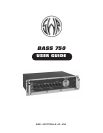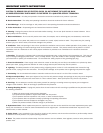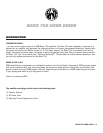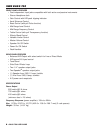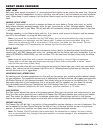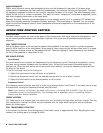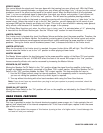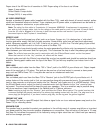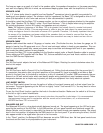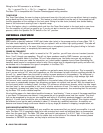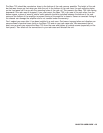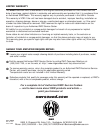
FRONT PANEL FEATURES
INPUT JACKS
Both input jacks accept a standard 1/4" phone plug and both inputs can be used at the same time. Since the
two inputs are totally independent, no loss in volume or tone will occur if two instruments are used simultane-
ously. Please keep in mind, however, that the Active/Passive input has five times more gain than the Active
input.
PASSIVE/ACTIVE INPUT
A “passive” instrument has no built in preamp and does not use a battery. On the other hand, an “active”
bass utilizes a battery operated preamp, either for gain, tone controls, or both. Although labeled “Passive,”
the Passive input jack on your Bass 750 will work with all instruments having a maximum output of less than
1 volt RMS.
Generally speaking, try the Passive input jack first. If you hear a small amount of distortion and the preamp
clip LED is not activated, try using the Active input jack.
Note: If you would like to overdrive the first TUBE stage, this can be accomplished by using an external
preamp between your instrument and the Passive input. To obtain optimum sound when trying this,
make sure the preamp clip LED is not activated. If this occurs, turn down your Gain control. The first
preamp tube stage is NOT monitored by the preamp clip circuit for this reason.
ACTIVE INPUT
The Active input jack should be used with instruments having a built-in (on board) preamp that will produce
signals over 1 volt RMS. Basses with really “hot” pickups may find the Active input more compatible. If you’re
using a KEYBOARD or BASS PEDAL, etc. with the Bass 750, we have found the best choice to be the Active
input.
Note: Using the Active input with a passive instrument may result in a loss of high end transients.
Players who roll off their high end frequencies starting at about 2kHz or who prefer a “darker” sound
may find this input more to their liking.
If you hear some distortion with your active bass and are using the Active input jack, check your instrument’s
battery. Also, make sure that the preamp clip LED is not lit. Following these instructions can save you and a
service technician a lot of aggravation.
HEADPHONE JACK (STEREO ONLY)
By inserting a set of stereo headphones into this jack you can monitor your sound or practice without disturb-
ing your neighbors. The headphone volume level is adjusted by the Master Volume. We suggest you begin with
the Master Volume off (fully counter-clockwise), then slowly bring up the volume to the desired level. If you
hear some distortion in your headphones that is not present with the speakers on, turn down the volume.
You are probably overdriving your headphones and could damage them (not to mention your ears).
Note: Any impedance headphones will work. However, optimum impedance is 75 ohms.
GAIN CONTROL
The Gain control adjusts the volume of the preamp section. After the tone controls and limiter are set to your
liking, the Gain control should be set to where the Preamp Clip LED barely flashes upon striking your loudest
note. Then adjust the Master Volume to the desired volume level. Utilizing these controls in this manner
assures the user of maximum signal to noise ratio with no distortion caused by the preamp circuits “clipping.”
PREAMP CLIP LED
The Preamp Clip LED will light if any portion of the preamplifier reaches clipping or runs out of headroom. This
can be caused by the Gain Control being set too high or if any of the tone controls are set in a high boost
position. To correct this condition, turn down one of the previously mentioned controls.
Note: The Preamp Clip LED indicates that at some point the preamplifier is clipping. No harm is being
done to your amplifier but, clipping of the power amplifier can cause damage to your loudspeakers and
is not recommended.
BASS 750 USER GUIDE • 3



